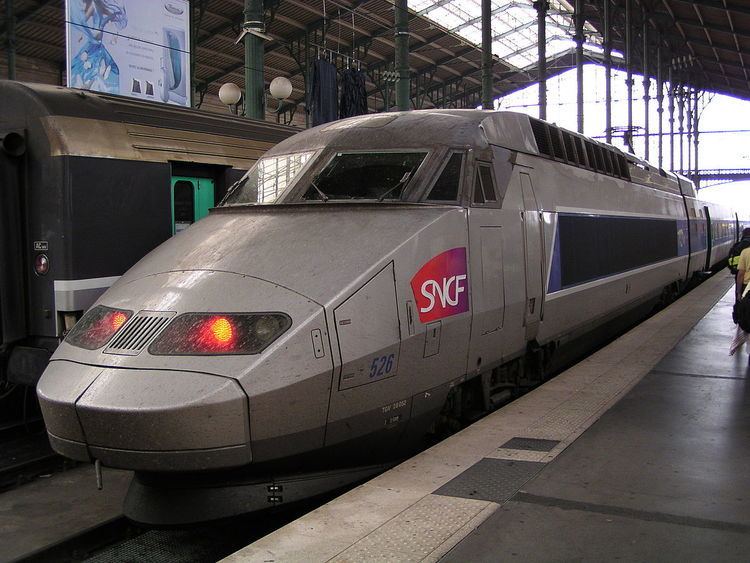In service 1993 - Family name TGV | Manufacturer GEC-Alsthom Number built 60 trainsets | |
 | ||
Formation 10 cars (2 power cars, 8 passenger cars) Capacity 377, 361 (after refurbishment) | ||
The SNCF TGV Réseau (TGV-R) trains were built by Alstom between 1992 and 1996. These TGV trainsets are based on the earlier TGV Atlantique.
The first Réseau ("Network") sets entered service in 1993. Fifty dual-voltage trainsets were built in 1992-1994, numbered 501-550. A further 40 triple-voltage trainsets, numbered 4501-4540, were built in 1994-1996. The last ten triple voltage units carry the Thalys livery and are known as Thalys PBA (Paris-Brussels-Amsterdam) sets. As well as using standard French voltages of 25 kV AC and 1,500 V DC (also used in the Netherlands), the triple voltage sets can operate under the Belgian and Italian 3 kV DC supplies.
They are formed of two power cars (8,800 kW or 11,800 hp under 25 kV—like the TGV Atlantique) and eight carriages, giving a capacity of 377 seats. They have a top speed of 300 km/h (186 mph). They are 200 m (656 ft) long and are 2.904 m (9 ft 6.3 in) wide. The dual-voltage sets weigh 383 t (377 long tons; 422 short tons), and owing to axle-load restrictions in Belgium the triple-voltage sets have a series of modifications, such as the replacement of steel with aluminium and hollow axles, to reduce the weight to under 17 t (16.7 long tons; 18.7 short tons) per axle.
Owing to early complaints of uncomfortable pressure changes when entering tunnels at high speed on the LGV Atlantique, the Réseau sets are pressure-sealed.
Renovation
After some ten years of successful service, the interior of TGV Réseau sets became outdated and needed a refurbishment. This refurbishment was part of the TGV Est project, as the dual-voltage sets were to assure the domestic services there. The same interiors would also be used in coaches for POS sets (which were coaches of former TGV-Réseau sets).
Three possible interiors were presented to the public between 2002 and 2003 in different stations:
At the end of the Train Capitale exposition in Paris, MBD Design and Christian Lacroix were announced as the winning design.
Work started on the first dual-voltage sets in 2004 at SNCF's Hellemmes workshops, near Lille. In 2006 the last dual-voltage set was finished. Between 2008 and 2009 the three-voltage sets will also be refurbished in the same design. The refurbished sets can be distinguished from the non-refurbished ones by: the slightly changed livery; the fittings in the coaches, which are in new colours (red for 2nd class, yellow-green for 1st class and silver for the bar) and the reflecting stripes on the sides of the motorcars.
Although SNCF announced in July 2007 that the Lacroix-design would not be continued because some materials vibrated at 300 km/h (186 mph), this was later changed: the Lacroix-design will be applied to all TGV Réseau sets.
